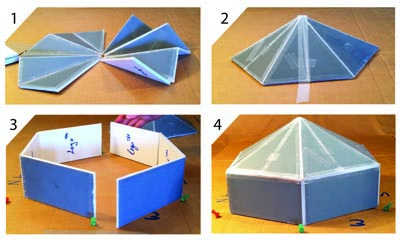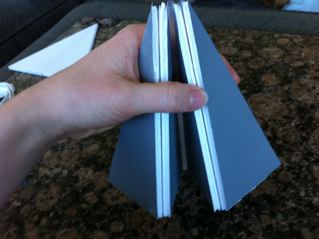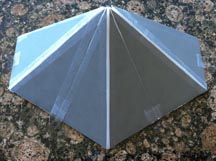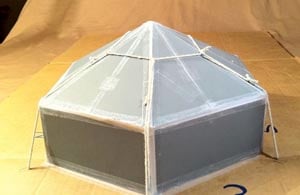Juliedanger (talk | contribs) |
No edit summary |
||
| Line 1: | Line 1: | ||
[[Category:Hexayurt project]] | [[Category:Hexayurt project]] | ||
[[ | [[Image:Campdanger4step.jpg]] | ||
'''1''' Two pre-made, accordion folding roof halves are taped together...to form '''2''' the roof-cone.<br />'''3''' Two accordion folding wall halves are taped together...'''4''' roof is taped to walls.<br />Hinges made with tape allow the yurt to accordion fold, without mitering or special materials. | '''1''' Two pre-made, accordion folding roof halves are taped together ... to form '''2''' the roof-cone.<br />'''3''' Two accordion folding wall halves are taped together ... '''4''' roof is taped to walls.<br />Hinges made with tape allow the yurt to accordion fold, without mitering or special materials. | ||
'''Download the PDF guide''' to the construction of this hexayurt: [[File:CDHexayurt_Instruction_PDF.pdf]] (this is a handy reference, but it is incomplete without the instructions and video on this page. | '''Download [[File:CDHexayurt_Instruction_PDF.pdf|the PDF guide]]''' to the construction of this hexayurt: [[File:CDHexayurt_Instruction_PDF.pdf]] (this is a handy reference, but it is incomplete without the instructions and video on this page. | ||
= Work in progress = | = Work in progress = | ||
Revision as of 15:48, 17 May 2011
1 Two pre-made, accordion folding roof halves are taped together ... to form 2 the roof-cone.
3 Two accordion folding wall halves are taped together ... 4 roof is taped to walls.
Hinges made with tape allow the yurt to accordion fold, without mitering or special materials.
Download 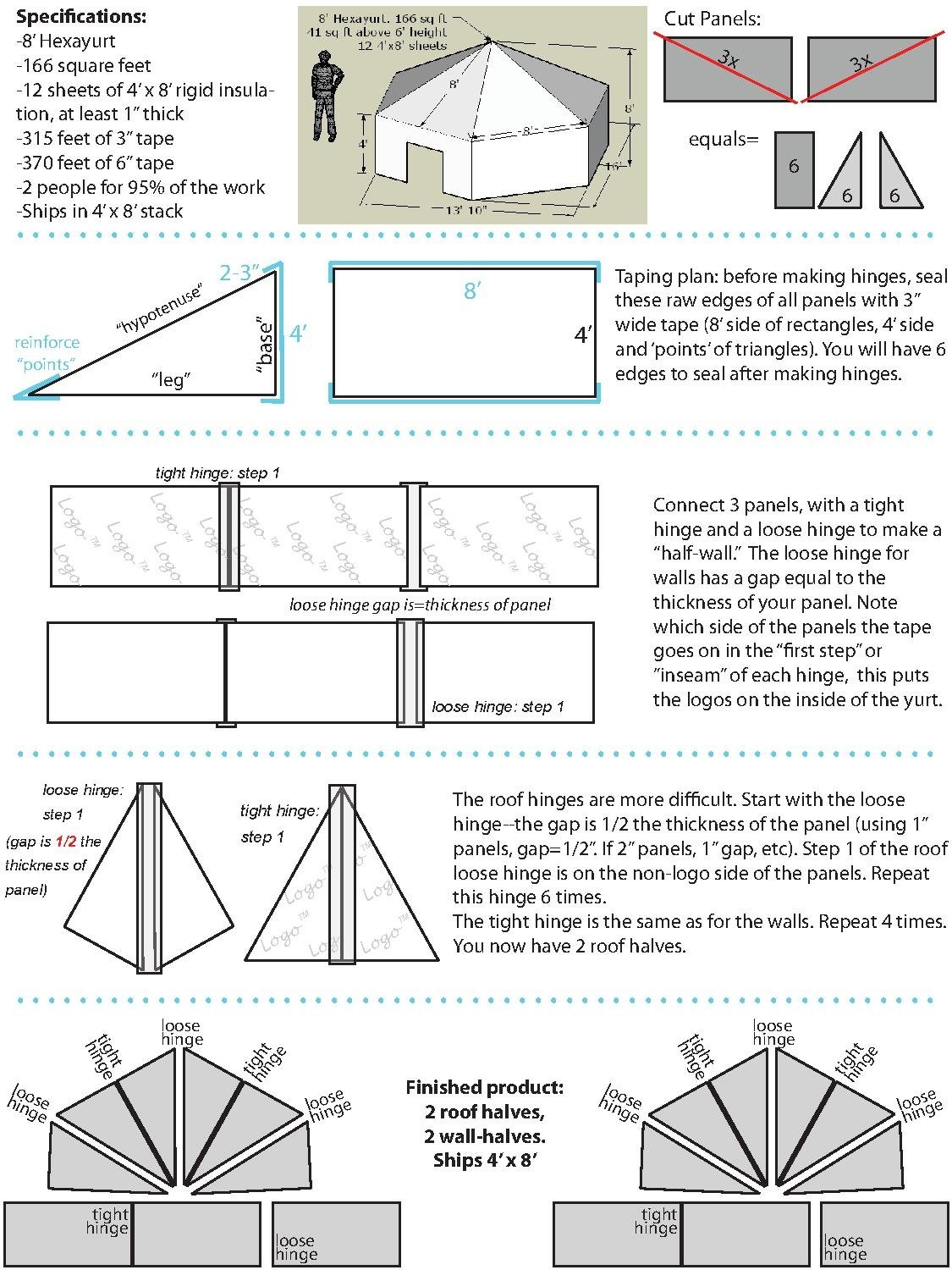 to the construction of this hexayurt:
to the construction of this hexayurt:  (this is a handy reference, but it is incomplete without the instructions and video on this page.
(this is a handy reference, but it is incomplete without the instructions and video on this page.
Work in progress
- WARNING: THIS IS WORK IN PROGRESS SO PLEASE USE WITH CARE, OR ONLY IN MODELS, UNTIL WE'RE DONE. THANK YOU & DON'T SAY YOU WEREN'T WARNED!
- ### SIGNALS NEED FOR CLARIFICATION OR EDITING.
- This page may end up after Hexayurt_playa#Partial_Folding_Hexayurt.
- We're working here for clarity and because there are many pictures.
Camp-Danger Two-Part Folding Hexayurt
This page describes a hinge technique that allows you to pre-fabricate any light-panel (rigid insulation) hexayurt as a semi-folding hexayurt. These instructions describe the technique for the popular 8' Hexayurt. The hinge technique can be used for other hexayurt shapes/sizes (coming soon!) We happen to be Burning Man participants, so some data is particular to that environment.
Videos: Start Here!
Camp Danger Semi-Folding hexayurt transports flat & assembles quickly: [1]
How to make the hinges for the folding walls: [2]
How to make the hinges for the folding roof: [3]
Preparation: what to seal with tape before making hinges: [4]
Advantages
- Your roof cone is pre-assembled in two halves that accordion-fold open. The walls will accordion fold in two halves as well. Other folding hexayurts require you use fancy tools to miter the edges of the panels-- this requires only tape.
- 90% of the work will already be done when you get to Burning Man. You will skip all the difficult and labor-intensive steps of "constructing the roof cone." Preferable in the elements of the Black Rock Desert: wind, dust, sun, heat. Watch the video of classic hexayurt roof cone construction to see how painfully tedious it is: Google Video
- Incidentally, the hinges you make form the exact angles that the hexagon walls and the roof need to have once assembled.
- 4'x8' stack of panels to transport (as usual)
- Usually, you seal all panel edges with tape first. Here, you should save tape because parts of the panels are sealed by creating the tape-hinges. These instructions also give you the option to use a mix of 3” and 6” tape, which will save you money. ### Estimate of savings?
- You will need two people for most of the process. You will need 5 people for about 5 minutes when you lift the roof onto the walls.
Folding with Tight and Loose hinges
How to make an accordion-folded yurt:
- You will make tape "hinges" that allow your roof and walls to be pre-assembled in accordion-folding halves.
- For the walls there is a "tight hinge" and a "loose hinge". The loose hinge for the walls has a gap between panels that is equal to the thickness of your panels (see images, it's too hard to read).
- For the roof there's a "tight hinge." Again there is a "loose hinge," but for the roof, it has a gap between panels that is half of the thickness of your panels.
This method is summarized here for the classic 8' hexayurt (12 4'x8' panels), but it should work with variations for other "light panel" hexayurts, like the stretch hexayurts and specifically for the H13. More will be posted on that later.
Designers
Design and instructions by Julie Danger and Chris Camp, at Burning Man 2010.
Step By Step Instructions
Sequence:
- Buy stuff.
- Make the hexayurt at home with two people (cut panels, tape-seal the edges, make tape-hinges, cut windows and door.) It's been done with just one person, but it's not very fun.
- Test out the yurt at home: do not skip this step!
- Package for transport
- Connect the half-walls
- Connect the half-roofs
- Tape roof on top of the walls (need 5 people)
- Fix it to the ground
- Tape-seal the yurt to your ground tarp to seal out dust.
- Maybe add some good-to-haves.
- Live in it.
- Cut some tape to fold it again.
- Take it back home.
Prepare
Buy stuff
For a detailed list, read the hexayurt playa checklist: [5]
- Mail-order tape (don't delay in ordering tape!) Most instructions require 6" tape. This is excessive, expensive, and hard to work with. A mix of 3" and 6" tape is recommended.
- Panels: 12 panels of rigid insulation, come 4' foot by 8' foot. Usually 1 inch thick, but you can use 2 inch thick panels for greater insulation.
- Utility Knife and blades (or power tools if you have them)
- Masks, Goggles, Gloves
- Broom: useful in construction, also a good tool in any Burning Man camp.
Begin Construction: Read this List of Pitfalls First
List of Pitfalls: read this prior to and during construction. These are mistakes you want to avoid.
- Cutting panels: forgetting to switch the direction you're cutting in (3 panels are cut left to right, 3 are right to left)
- Tape hinges: forgetting which side of the hinge the logos are on (keep PDF nearby as a guide)
- Roof Tape Hinges: forgetting that the loose hinge gap is 1/2 thickness of the panels
- Roof Cone Construction: aligning the roof cone points instead of the bases. Align the bases so that they sit flat on the walls.
- Final assembly: if you are at Burning Man, don't forget to drive at least 2-3 stakes into the ground and have some rope available. Use your walls or assembled roof cone as a guide for the footprint of the yurt. This way if a dust storm appears when your yurt is taped together, you can tie it down temporarily. While this possibility seems slim, I assure you it has happened. A hexayurt not tied down is a large, delicate kite.
Download the PDF guide to the construction of this hexayurt:  (this is a handy reference, but it is incomplete without the instructions and video on this page.)
(this is a handy reference, but it is incomplete without the instructions and video on this page.)
Turn half of the panels into triangles
At home, prepare the panels. Do this before arriving at Burning Man because the fiberglass will litter the playa. In fact, try to always pre-make anything for Burning Man, the environment is unforgiving. This is best done with two people.
- Six panels will be used for the roof cone. Most brands of panel have logos on one side. You probably want the logos facing inside of the yurt, so cut them this way:
- Draw a diagonal line, left to right, corner to corner, on three of the panels using the ruler, or another panel, or a piece of string, as a guide.
- Draw a diagonal line, right to left, on another three panels.
(Pitfall alert: "Cutting panels: (3 panels are cut left to right, 3 are right to left. Otherwise logos will not all face inward.")
- Put on your gloves, mask and goggles. This protects you from little bits of fiberglass from the panels.
- Using the snap-blade craft knife, extended about two inches, cut the panels. Expect to change the blade every panel or so, and change the blade as soon as you feel the knife tearing the material rather than cutting cleanly. (Many people use craft knives. If you have adequate power tools it's recommended (a reciprocating saw and a steady hand worked well.)
- You now have 12 right-angle triangles.
Tape-Seal Certain Edges
You use tape to seal all edges of the raw panels to protect you and the playa from the fiberglass, and to strengthen the fragile panels. Read more about that here: [[6]] Because the tape hinges you'll make next seal some of the edges, tape-seal only these edges now. If you seal all the edges now, you'll be wasting tape. You will have 6 edges left after you make hinges, but worry about those later. We recommend using 3" wide tape because it's cheaper, and easier to work with. Best with 2 people.
- Tape the 8 foot edges on all the rectangular wall panels, but do not tape the 4" sections yet.
- Tape the 'bases'/'short sides' (2" sides) of all of the triangular roof panels.
- Tape just the pointy "tips" of the roof triangles for reinforcement.
- The best way of doing this is to start the tape about 2-3" from the edge you're sealing, to ensure a strong corner and a complete seal. See image below. There is a trick to keeping the tape tidy at the corners shown, in the video [7], it prevents the tape bunching up and adding mass.
Watch the video: [8]

Walls

6 panels make the hexagon walls. 3 panels make a half-wall. You'll make 2 half-walls. It is not recommended to connect all 6 panels, because it's too bulky to work with. Half-walls are manageable and stabilize the roof halves during shipping.
Tight hinges for the walls

Watch the video, it's very quick and explanatory: [9]
1: Lay two 4x8 wall panels next to each other, logo side up, tightly butting the 4' sections together. Pitfall Alert: Logo side of the panel faces up.
2: Tape them together while they are flat. This creates what's called the 'inside seam' of the hinge. You can use 3" tape.
3: Stand them up and close the two panels like a book. Think of this like bookbinding on the spine of a book: you closed the book at this hinge.
4: Complete the hinge by taping "the spine of the book". Use 6" tape. This step seals the raw edge of the panel.
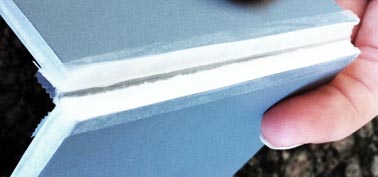
Loose hinges for the walls

Watch the very helpful video (min 1.06): [10]
The "loose hinge" is the "magic" of this style of yurt: the flexible hinge allows you to accordion fold the panels for transport. This technique is even more valuable on the roof cone! You will attach the 3rd panel of the half-wall with a loose hinge.
1: For the loose hinge, you need a gap between wall panels that is equal to the thickness of your panel. If using 1" thick material this gap will be 1". If using 2" insulation, a 2" gap, etc. Use another panel as a "spacer" to get the right distance.
2: Tape the panels flat, non-logo side up. You can use 3" tape here, carefully. Notice the gap!
3: Next, use your other panel as a spacer again. Close the spacer into the hinge, then do the "bookbinding" style taping on this hinge as well - you will need 6" tape.
Recall that when the sticky tape touches itself the bond is very strong. Now you have a flexible hinge, to make the accordion-folding work for transport. You can try this right now if you have 3 DVD boxes or something similar and some tape.
Cut a Door
Don't forget to cut a door. The door is the most difficult part of the 8' hexayurt. See some ideas here: [[11]]. Windows are also good to cut now: [[12]]
Roof

1: Right/Small Triangle 2: Isosceles/Big Triangle 3: "Kite" 4: "Roof Half" with tight and loose hinges
Having common words during construction is worthwhile, so let's review geometry just momentarily. Twelve small-triangles aka right-triangles make the roof cone. Two small-triangles joined by their legs make a big triangle or isosceles triangle. Or, 2 small triangles joined at hypoteneuse form a "kite." Six small-triangles (1+2+2+1) make a half-roof. you will make 2 half-roofs.
About Roof Joints, Angles and Hinges
There are two kinds of joints in the roof:
- "Hypotenuse joints": where the hypotenuses of two right triangles are joined. These joints are where the shape of the roof is angled, they are very important. They will have loose hinges -- but beware: not with a full 1-panel-sized gap as on the walls, but with a gap half that size. Making the gap 1/2 width happens to form the perfect angle for the roof--this stabilizes the roof cone and makes things easier (that's the magic of geometry.) You will notice that the roof is divided in halves so that all of these hypotenuse joints are pre-fabricated. The reason is, it's a lot easier to tape the vertical joints together-- they are flat, so you don't have to measure and ensure the angle is correct.
- "Vertical joints": where the legs of two triangles meet. They will have tight hinges, because the two half-side triangles together act as one-side triangle that goes on one wall.
Make Roof Loose Hinges

Definitely watch the video: [13]
Pitfall Alert: the loose hinge for the roof changes: the gap is one half the thickness of the panel. (this means that if you use 1" thick insulation panels, your gap for the roof-cone-tricky-hinges will be about 1/2". If you use 2" thick, it'll be 1", etc etc. You may find the panels are a little thicker than 1"--don't worry about it, the tape is very forgiving.)
Unlike the wall sections, start construction with the loose hinges because otherwise you end up juggling several panels. Find a spacer that's the right thickness. For the miniature, a cookbook cover was about 1/2 the thickness of the mini-panels. For full size, a bit of spare lumber from the garage that was the right thickness.
1: Tape two hypotenuses together laying flat, with your 1/2-thickness gap between. 3" tape is ok. (pitfall alert: the non-logo side of the panels should be facing up if you want the logos on the inside of the yurt.)
2: Close the hinge, and use your spacer to help finish the other side of the hinge (the 'bookbinding' part that seals the raw edges of the insulation.) Use 6" tape for this part.
You will do the loose hinge 6 times or until you run out of hypotenuses. This gives you 6 "kites."
Make Roof Tight Hinges
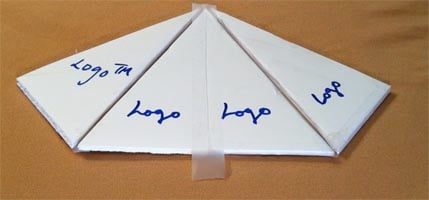
Watch the Video (start at min 2:13) [14]
Pitfall alert: Sometimes one triangle is bigger than the other because of imprecise cutting of panels. not a problem, but align the triangle bases so that they sit flat on the walls. Do not align the triangles at the roof-points- that part doesn't matter.
1: Tape two "kites" together, without a gap (forms the 'vertical joint'). Logos should be facing up for this step. 3" tape is ok.
2: Same as with the walls: close the two panels at this hinge and tape-seal the back of the hinge like 'bookbinding' with 6" tape.
You will connect 3 "kites" with tight hinges. You now have two half roofs.
The roof could be divided in half on a different axis, preventing you from making so many of the more difficult "loose hinge," but as said above: the loose hinges dictate the angle of the roof, and when you join the two roof halves, it is much easier to connect them along the "vertical joint," because it does not require a gap.
Fold the semi-roof
The gap you created with the loose hinge creates the perfect angle for your roof-cone. Therefore, when you open the roof cone, it "snaps" to the correct shape for placing on top of the walls. Two roof cones, folded up, equal the 4' x 8' shipping footprint.
Final Tape-Seal
You now have 8 exposed panel edges left that aren't tape-sealed, seal them with 3" tape. Seal any raw edge that remains unsealed.
Prepare your tarp
Some people cut their tarp into hexagon slightly larger than the walls. This is nice because it looks tidy and especially in the case of rain: you can tape-seal the tarp edges up the walls of the hexayurt and prevent any leakage during a heavy rain (even though you tape-seal the bottom of the walls both inside and out to the tarp, heavy rains will puddle at the corners and leak in.) You don't need a hexagonal tarp, but be aware that one side of the tarp will be too long and will need to get out of the way of your ground stakes. Two smaller tarps taped together on both sides with the bidirectional filament tape works fine (ps: big tarps are expensive!)
Test your Hexayurt
For classic yurts, it is essential to build them at home for practice. The semi-folding yurt is much less difficult during final assembly because of the pre-fabricated hinges. Despite this, it is recommended to build it at least once, and it's very satisfying after all the work. A tennis court is usually clean and flat, parking lots, etc. If you want to conserve tape, you can tape it together with just tape-patches-- 6" tape, about 6-10 inches long at all the corners and along the joints.
Transport
8-foot hexayurts have successfully arrived at Burning Man on top of cars as small as sedans-- however, that's probably not recommended. There are 2 approaches for transport: Tarp or Plywood. There's been accounts of panels being "wrecked" by the vibration and force of air (not sure if these panel edges were already tape-sealed)
- Plywood: Preferable because tarps make a lot of flapping noise in the wind. Stack a half wall, then the roof cones, then the other half wall. The wall-halfs stabilize the roof cone. Sandwich the stack between two sheets of 4'x8' plywood. Tie them together tightly.
- Tarp: Stack the half walls and roofs as above, wrap the bundle very tightly in your ground tarp like a flat burrito. The tighter it is, the more study and less noisy in the wind.
- The entire package is an easy carry for two people. It weighs significantly under 100 lbs. It is quite large.
Assembly
- Now we have dust and heat to consider. The reflective panels are like an oven when the full sun is on them. Plan on working when dust and heat are minimized - early morning is the best time because of minimized heat and wind. If you arrive in the day, you can try the late afternoon, before dusk. No matter how eager you are, don't stupidly lose your yurt by setting up in high wind.
- People: just 2-3 people for most assembly, 5 or more for about 15 minutes while lifting the roof onto walls. 3 is nice for taping the walls to the tarp, because 6" tape is so unwieldy in long strips.
- Never peel tape back off the boards carelessly, because you can rip the foil right off, never cut the board material on the playa because it generates moop/litter.
Tape together Roof-Halfs
This is more difficult than the walls, but the roof is less likely than the walls to blow away once taped together. Besides, you're probably very excited, so use your energy now. Consider excellent rain protection in this step-- as much as this possibility seems slim, rain happens. The challenge of roof taping is that you can't reach all the way up the roof cone, however a broom is very handy at this phase. You can also tape from inside the roof cone, but that's not protective against rain. Use a few "tape patches" (segments of 6" tape-- about 3-10 inches long) to get the roof cone into position, with the halves tightly butted together. Tape patches will make your life much easier and are surprisingly strong. (Video: [15] This technique may need some improvement, but the way to tape the halves together and seal out rain is to create 1 long (over 16") length of tape, held between two people and lifted over the roof with the help of a broom handle. Use the broom handle to land the tape at the tip of the roof cone, try to make it even but don't be too concerned. Then use the bristles of the broom to smooth the tape down to the roof panels. You can add another shorter piece of tape in the opposite direction if you're concerned about rain protection-- this piece doesn't have to be the full 16", but you do need to be able to reach without falling onto your roof cone. Do make some sort of mark where you taped the roof together, or later you'll forget and cut one of your hinges accidently. See the video: [16] If you are using tape-anchors for to stake your hexayurt down, make them now. (see below: [[17]]
Drive at least 3 stakes into the ground
Pitfall Alert: if you are at Burning Man, don't forget to drive at least 3 stakes into the ground and have some rope available (one piece already tied into a "halo"). Use your assembled roof cone as a guide for the footprint of the yurt so you know where to put stakes. This way if a dust storm appears when your yurt is taped together, you can throw the halo over, and tie it down temporarily at those 3 points--it does not need to have a perfectly even shape, but good tension. While this "rogue dust storm" possibility seems slim, I assure you it has happened, and occupied 4 or 5 unhappy people who dutifully held the yurt down for 45 minutes instead of hiding indoors. A hexayurt not tied down is a large, delicate kite, and it's your home blowing away. This means you'll have stakes to trip over during assembly-- be careful! At worst, if a big wind appears, cut the new tape and fold the yurt down until it's over.
Tape together wall-halfs
You can do this from inside the walls, or from outside (you'll tape with a gap that's equal to the thickness of the panels again.) You can tape both sides if you'd like. Consider the possibility of rain as you do this. Do make some sort of mark where you taped the walls together, or later you'll forget and cut one of your hinges accidently. Move your roof cone out of the ground stakes, put down your ground tarp, and move the completed walls on top of the tarp.
Place the roof on top of the walls
(Optional:) make your life a little easier with some more tape-patches: from the outside of the roof cone, put a little 6" tape on each of the "vertical joints," partway up the roof cone. This will 'lock' the hinges and keep the roof cone shape sturdier as you lift and adjust it. Lift: You'll need at least 5 people for this. Give each person 2 or 3 tape-patches--attach them to their clothing before lifting. ‘’’Lift the roof cone from the hypotenuse corners,’’’ and settle it onto the walls. One person is designated to start the tape-patching, they should align their roof and wall corners and tape-patch it in place. After that, stick a patch in the middle of the wall too. Everyone else can tape their corners as the corners line up, and add a patch in the middle of the walls. Don't be too precise: the tape ring that finally secures the roof will not be affected if things don't line up perfectly. See the video: [18] Tape Ring: This is what structurally completes the yurt: a (preferably unbroken) ring of 6" tape all the way around the roof-to-wall joint. Start in the middle of a wall, and center the tape over the seam between roof and wall. You run the tape all the way around the yurt. The tape makes a nice noise as you zoom it out along each side, and people get very excited. Again, there's a way to snip the tape that sticks up above the joint so that it is tidy and seals well when you smooth it over the roof panels (see video: [19])
Fix to the ground
Stake to the ground before taping the yurt to the tarp: see "delicate kite in high wind" section above. Drive in your final ground stakes--6 total (rebar "staples" are great because they come out easier during cleanup.) Stakes should be pretty close to the bottom of the yurt. Make sure to pad the ends and mark the guy lines with something easy to see at night. There are two main techniques for tie-down, the halo or tape-anchors: Tape Anchors: They are aesthetically better than a rope-halo because they are unnoticeable on the surface of the yurt. They are very strong, however they require a lot more of the expensive 6" tape. Their construction is discussed here: [[20]] Rope Halo: cheaper and faster. Definitely have one available even if you're planning to use tape-anchors in case of sudden winds. Make a circle out of rope-- big enough that it rests on the roof cone somewhere that you can reach it. Fasten from the halo to the ground stakes with 6 other sections of rope. Now you can take the time to make everything equal lengths and pretty. Need some extra hands for this part.
Tape to the Tarp
This part is the last structural reinforcement, but mostly about dust prevention, and also somewhat to do with rain. Some people tape the walls to the tarp both inside and outside. Others only in or out. Taping outside seems most important for rain protection. Use 6" tape to connect the tarp to the walls. Three people is useful for this part to keep the tape tidy-- you especially want a smooth edge to seal against rain.
Other things you can add
(((door, windows, air, etc)))
Other Shapes, Increased Height
If you want to move increase head room in a hexayurt and create a taller entryway, there are two good options that can still be made semi-folding with this style hinge: Hexayurt H13
Hexayurt H13 This yurt design adds just one more 8'x4' panel (hence the name: "H13), and raises one side of the hexayurt with an 8' gable, allowing increased headroom and a good face for a door. It's a bit trickier than the standard 8' hexayurt because it is asymmetrical on one axis. Check out the PDF guide: 
The other option is to increase the height of the entire 8' hexayurt: add 2' all around with 3 more panels, cut in half lengthwise. If this has been done successfully in the winds at Burning Man, it would be good to know. The current idea is to change the wall sections to be 1 4x8 panel with the 2' section hinged on. You would stagger the 2' addition top and bottom when you build the walls to maintain stability. It would still ship in the 4'x8' stack. This means you have to tape all 6 walls together, but the accordion folding is more important on the roof cone than the walls. Here's a PDF guide to this plan: 10'_Hexayurt_instructional.pdf
